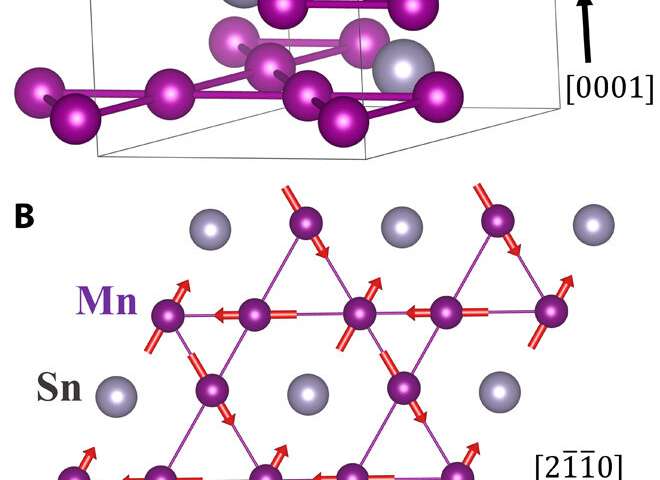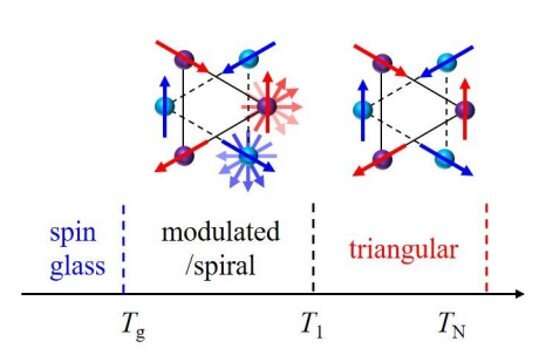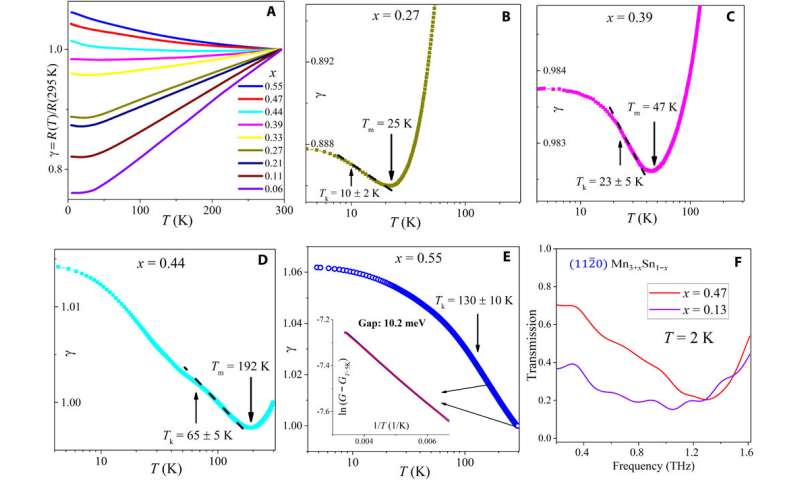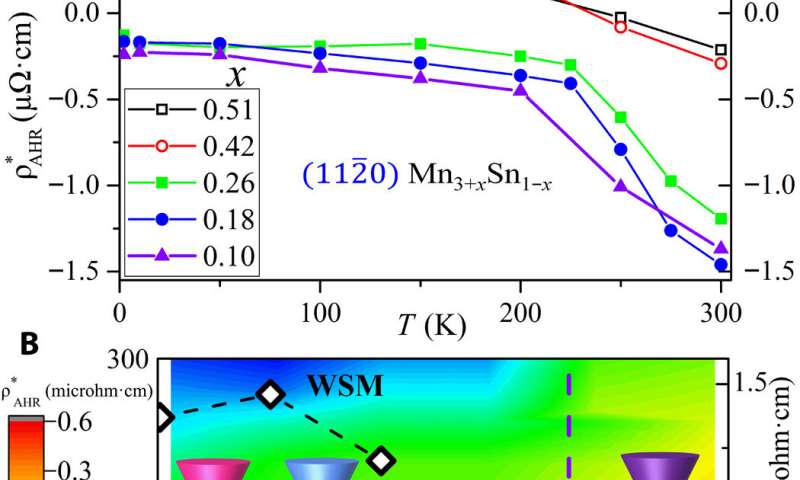#Kondo physics in antiferromagnetic Weyl semimetal films
“#Kondo physics in antiferromagnetic Weyl semimetal films”

Emerging quantum materials can be defined by topology and strong electron correlations, although their applications in experimental systems are relatively limited. Weyl semimetals incorporating magnetism offer a unique and fertile platform to explore emerging phenomena in developing topological matter and topological spintronics. The triangular antiferromagnet Mn3Sn exhibits many exotic physical properties as an antiferromagnetic (AFM) Weyl semimetal (WSM), including an attractively large spontaneous Hall effect.
The spontaneous Hall effect was discovered more than a century ago and understood in terms of time-reversal symmetry breaking by the internal spin structure of antiferromagnetic, ferromagnetic or skyrmionic (small swirling topological defects in the magnetization) forms.
In a new report now published on Science Advances, Durga Khadka and a team of scientists in physics, materials science, neutron research and engineering in the U.S. reported the synthesis of epitaxial Mn3 xSn1−x films with compositions similar to bulk samples. When they replaced the tin (Sn) atoms with magnetic manganese (Mn) atoms in the samples, they noted the Kondo effect; a celebrated example of strong correlations to emerge, then develop coherence and induce a hybridization energy gap. The process of magnetic doping and gap opening facilitated rich extraordinary properties for the new materials.
Weyl semimetals and the Kondo effect
Materials scientists study the band structure topology and design of materials as an increasingly important feature contributing to many exotic behaviors in novel quantum materials. The band theory or band structure defines the quantum-mechanical behavior of electrons in solids. Band structure topology is critical to understand the development of gapless topological semi-metals such as Weyl semimetals (WSMs) and Dirac semimetals that are three-dimensional (3-D) analogs of graphene.
Weyl semimetals are solid state crystals with low energy excitations known as Weyl fermions that carry electrical charge under room temperature. The conduction and valence bands of WSMs cross at specific points in momentum space, known as Weyl nodes, and their spacing in turn dictate the magnitude of the intrinsic anomalous Hall effect—an effect observed in solids with broken time-reversal symmetry or conservation of entropy. Weyl nodes appear as non-degenerate pairs with opposite chirality. Work thus far on WSMs have focused on weakly interacting systems with a growing need to include the effects of strong electron correlations. The Kondo effect is a classic example of strongly correlated behavior originating from the coupling between the spins of conduction electrons and local magnetic moments. This work suggests WSMs as a fertile platform to study new quantum phases due to the interplay between Weyl and Kondo physics.

Developing epitaxial Mn3 xSn1−x films
The team selected the antiferromagnetic Weyl semi-magnetic metal (WSM) Mn3Sn as a promising material to study the concepts. In the Mn3Sn hexagonal structure, the Mn atoms formed a 2-D Kagome lattice (a woven pattern composed of interlace triangles) with Sn atoms sitting at the hexagon centers. The scientists used angle-resolved photoemission spectroscopy (ARPES) measurements to observe the structural features. The outstanding topological and spintronic properties alongside strong correlations made Mn3Sn an ideal platform to study multifaceted physics between topology, magnetism, strong correlations and emerging antiferromagnetic spintronics.
Khadka et al. developed high quality epitaxial films and observed Kondo effects in films with excess Mn, which acted as a dopant in the system after substituting Sn. When they increased Mn doping, the system developed Kondo coherence and opened a hybridization gap. The Mn3Sn exhibited a strongly anisotropic Hall effect. The team used co-sputtering of Mn and Sn targets to realize epitaxial growth and create Mn3 xSn1−x films. Using X-ray diffraction (XRD) patterns they noted the absence of impurity peaks in the material and using atomic force microscopy they noted the surface roughness to be about 0.4 nanometers. Earlier research studies had shown the stability of hexagonal Mn3Sn films after excess Mn atoms replaced the Sn atoms. Consequently, doping with Mn effectively tuned the band structure topology and Hall effects in Mn3 xSn1−x films allowed the scientists to explore new and unusual correlations to understand the interplay between Weyl and correlation physics on an ideal platform.

Resonance-enhanced Faraday rotation and DC Hall resistances
The team further showed stronger evidence for gap opening of the films using terahertz Faraday rotation measurements. When they doped the Weyl semimetal (WSM) with magnetic Mn atoms, they noted a possible transition from the Kondo effect to Kondo insulator; a new class of topological matter, where the effects were independent of the crystalline growth orientation. Since the large spontaneous anomalous Hall resistance (AHR) arising from the Weyl nodes previously formed a salient transport feature in bulk Mn3Sn, Khadka et al. similarly identified the Weyl nature of the thin film used here with Hall measurements. The total Hall resistivity calculations considered the magnetization, ordinary Hall coefficient and magnetic permeability for the resulting unusual Hall resistances in the films.

Unusual magnetoresistance
Khadka et al. then recorded negative magnetoresistance (NMR) as another important transport feature in Weyl semimetals due to the chiral anomaly of the material. For instance, when they applied a magnetic field along the direction of the current, a chiral charge current drove from one Weyl node to its counterpart with opposite chirality. The combined chiral current improved the electric conductivity during the experiment, giving rise to negative magnetoresistance (NMR)—a feature that demonstrated the consequences of doping magnetic Mn atoms.
In this way, Durga Khadka and colleagues developed antiferromagnetic Weyl semimetal Mn3 xSn1−x thin films with superior sample quality. The exciting class of materials provided a platform to study the interplay between strong electron correlations, topology and magnetism. The team replaced tin (Sn) with magnetic manganese (Mn) to realize a Kondo effect that led to open a hybridization gap, accompanied with decreased Hall resistance. The work forms the basis for further studies on related materials including electron localization by doping atoms with diverse elements including iron, cobalt, copper or gadolinium. The team can further tune spin-orbit coupling of the thin films by doping heavy elements such as lead (Pb).
![Magnetoresistances of (0001) Mn3 xSn1−x films. Resistance change [R(H) − R(H = 0)] as a function of field for (A) x = 0.16 and (B) x = 0.51 at T = 2 K (blue) and T = 300 K (red). Credit: Science Advances, doi: 10.1126/sciadv.abc1977 Kondo physics in antiferromagnetic Weyl semimetal films](https://scx1.b-cdn.net/csz/news/800/2020/4-kondophysics.jpg)
Since conventional collinear antiferromagnetic materials do not exhibit anomalous Hall resistance effects due to their vanishingly small properties of magnetisation, they are not good candidates for antiferromagnetic spintronics. In contrast, the rich collinear spin textures, and substantial Hall resistances of the Mn3Sn family of compounds introduced in this work make it a promising candidate for such applications. These thin films will offer new paradigms to propel the emerging field of topological antiferromagnetic spintronics to develop new spin-based devices.
More information:
Durga Khadka et al. Kondo physics in antiferromagnetic Weyl semimetal Mn3 xSn1−x films, Science Advances (2020). DOI: 10.1126/sciadv.abc1977
Libor Šmejkal et al. Topological antiferromagnetic spintronics, Nature Physics (2018). DOI: 10.1038/s41567-018-0064-5
K. Kuroda et al. Evidence for magnetic Weyl fermions in a correlated metal, Nature Materials (2017). DOI: 10.1038/nmat4987
© 2020 Science X Network
Kondo physics in antiferromagnetic Weyl semimetal films (2020, September 8)
retrieved 8 September 2020
from https://phys.org/news/2020-09-kondo-physics-antiferromagnetic-weyl-semimetal.html
This document is subject to copyright. Apart from any fair dealing for the purpose of private study or research, no
part may be reproduced without the written permission. The content is provided for information purposes only.
If you want to read more Like this articles, you can visit our Science category.
if you want to watch Movies or Tv Shows go to Dizi.BuradaBiliyorum.Com for forums sites go to Forum.BuradaBiliyorum.Com



